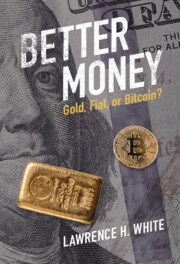Book contents
- Better Money
- Better Money
- Copyright page
- Dedication
- Contents
- Figures
- Acknowledgments
- Introduction
- 1 Markets and Governments in the History of Money
- 2 How a Gold Standard Works
- 3 Common Misconceptions about the Gold Standard
- 4 How a Fiat Standard Works
- 5 How a Bitcoin Standard Works
- 6 Comparing and Contrasting Gold and Bitcoin Standards
- References
- Index
5 - How a Bitcoin Standard Works
Published online by Cambridge University Press: 16 March 2023
- Better Money
- Better Money
- Copyright page
- Dedication
- Contents
- Figures
- Acknowledgments
- Introduction
- 1 Markets and Governments in the History of Money
- 2 How a Gold Standard Works
- 3 Common Misconceptions about the Gold Standard
- 4 How a Fiat Standard Works
- 5 How a Bitcoin Standard Works
- 6 Comparing and Contrasting Gold and Bitcoin Standards
- References
- Index
Summary
Chapter 5. Bitcoin emerged in 2009 from a community of libertarian cryptographers who sought an alternative payment system free from fiat inflation and from government payment surveillance and censorship. Today it provides an alternative payment rail that circumvents central banks. Bitcoin serves as a medium of exchange in some transactions, but not yet as a commonly accepted medium of exchange. The Bitcoin source code keeps the number of Bitcoin in circulation growing, at an ever-slowing rate, along a programmed quantity path. Basic monetary theory shows that this supply mechanism has pros and cons: It avoids money supply shocks, but it rules out any supply response to variations in demand, making the purchasing power of Bitcoin more volatile than that of gold or (relatively well-managed) fiat, which limits the attractiveness of holding Bitcoin as a medium of exchange. The costs of the Bitcoin industry are borne by its users, not by third parties, to the same extent as those of any energy-using private industry. The non-zero chance of its serving as a future global money means that Bitcoin has a fundamental value. It does not inherently rest on an unsustainable chain-letter or “bigger fool” process.
- Type
- Chapter
- Information
- Better MoneyGold, Fiat, or Bitcoin?, pp. 153 - 190Publisher: Cambridge University PressPrint publication year: 2023



